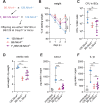A hierarchy of cell death pathways confers layered resistance to shigellosis in mice
- PMID: 36645406
- PMCID: PMC9876568
- DOI: 10.7554/eLife.83639
A hierarchy of cell death pathways confers layered resistance to shigellosis in mice
Abstract
Bacteria of the genus Shigella cause shigellosis, a severe gastrointestinal disease driven by bacterial colonization of colonic intestinal epithelial cells. Vertebrates have evolved programmed cell death pathways that sense invasive enteric pathogens and eliminate their intracellular niche. Previously we reported that genetic removal of one such pathway, the NAIP-NLRC4 inflammasome, is sufficient to convert mice from resistant to susceptible to oral Shigella flexneri challenge (Mitchell et al., 2020). Here, we investigate the protective role of additional cell death pathways during oral mouse Shigella infection. We find that the Caspase-11 inflammasome, which senses Shigella LPS, restricts Shigella colonization of the intestinal epithelium in the absence of NAIP-NLRC4. However, this protection is limited when Shigella expresses OspC3, an effector that antagonizes Caspase-11 activity. TNFα, a cytokine that activates Caspase-8-dependent apoptosis, also provides potent protection from Shigella colonization of the intestinal epithelium when mice lack both NAIP-NLRC4 and Caspase-11. The combined genetic removal of Caspases-1, -11, and -8 renders mice hyper-susceptible to oral Shigella infection. Our findings uncover a layered hierarchy of cell death pathways that limit the ability of an invasive gastrointestinal pathogen to cause disease.
Keywords: Shigella; immunology; infectious disease; inflammation; intestine; microbiology; mouse; pathogenesis.
© 2023, Roncaioli et al.
Conflict of interest statement
JR, JB, RC, FL, ET, AL, CL No competing interests declared, RV Reviewing editor, eLife
Figures













References
-
- Alphonse N, Wanford JJ, Voak AA, Gay J, Venkhaya S, Burroughs O, Mathew S, Lee T, Evans SL, Zhao W, Frowde K, Alrehaili A, Dickenson RE, Munk M, Panina S, Mahmood IF, Llorian M, Stanifer ML, Boulant S, Berchtold MW, Bergeron JRC, Wack A, Lesser CF, Odendall C. A family of conserved bacterial virulence factors dampens interferon responses by blocking calcium signaling. Cell. 2022;185:2354–2369. doi: 10.1016/j.cell.2022.04.028. - DOI - PMC - PubMed
-
- Arondel J, Singer M, Matsukawa A, Zychlinsky A, Sansonetti PJ. Increased interleukin-1 (IL-1) and imbalance between IL-1 and IL-1 receptor antagonist during acute inflammation in experimental shigellosis. Infection and Immunity. 1999;67:6056–6066. doi: 10.1128/IAI.67.11.6056-6066.1999. - DOI - PMC - PubMed
Publication types
MeSH terms
Substances
Grants and funding
LinkOut - more resources
Full Text Sources
Molecular Biology Databases

